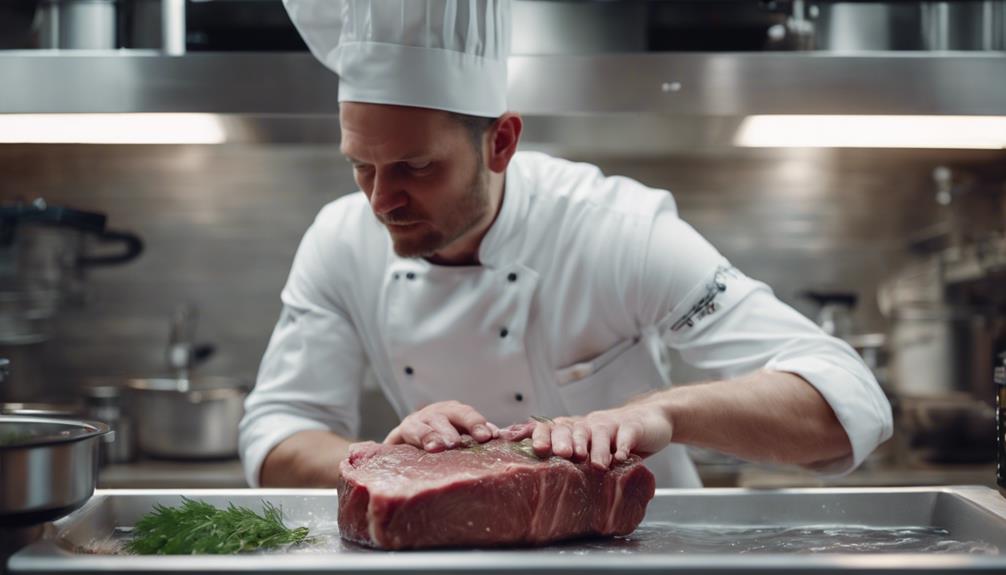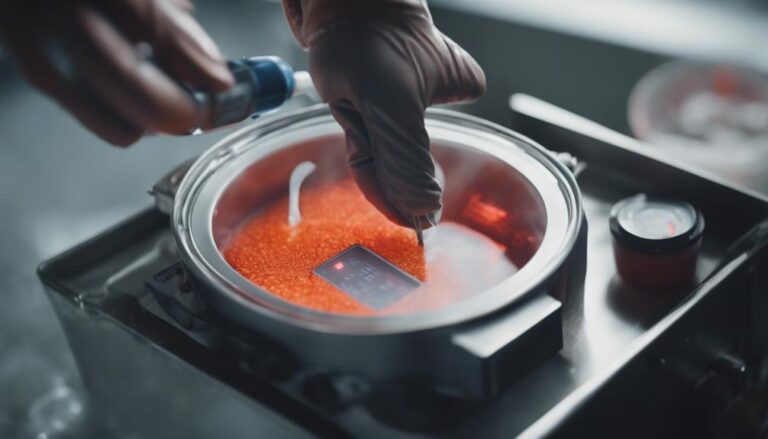Ensuring Safe and Delicious Sous Vide Cooking Experience
To guarantee a safe and delicious sous vide cooking experience, prioritize precise temperature control. Seal your food tightly in approved pouches, eliminating air bubbles. Keep a close eye on heat processes and follow safety guidelines. Prevent bacterial growth by vacuum sealing and maintaining hygienic practices. Achieve safe and flavorful dishes by understanding pasteurization times and storage recommendations. Enhance your culinary experience through proper techniques. Ready to elevate your sous vide skills further? Stay tuned for expert insights on mastering safety and flavor in sous vide cooking.
What You Will Learn Here
- Maintain precise temperature control for safety and flavor.
- Vacuum seal to inhibit bacterial growth and retain nutrients.
- Follow recommended cooking times and pasteurization guidelines.
- Rapidly chill cooked foods to prevent bacterial proliferation.
- Store sous vide foods properly to ensure freshness and safety.
Safety Guidelines for Sous Vide Cooking
To guarantee safe and successful sous vide cooking, it's essential to adhere to specific safety guidelines. When engaging in sous vide cooking, always prioritize using sous vide safe temperatures ranging between 55°C and 90°C. These temperatures help minimize risks and guarantee that your food is cooked thoroughly and safely.
Additionally, make sure to utilize vacuum-sealed pouches approved for sous vide cooking. These pouches not only help in maintaining the flavors and nutrients of your ingredients but also prevent harmful chemicals like BPA and phthalates from leaching into your food.
Proper heat processes are essential, especially when dealing with cook-chilled foods in sous vide cooking. By following specific times and temperatures tailored to different foods, you can ensure a safe cooking process. Remember, using vacuum sealing techniques and adhering to hygiene standards are paramount to prevent any harmful bacterial growth during sous vide cooking.
Proper Vacuum Sealing Techniques
When vacuum sealing for sous vide cooking, remember to seal your bags tightly to eliminate any air bubbles. This step guarantees that the food cooks evenly and retains its flavor.
Proper vacuum sealing techniques are essential for a successful sous vide cooking experience.
Seal Bags Tightly
For successful sous vide cooking, make sure that your vacuum-sealed bags are tightly sealed to promote even heat distribution and prevent bacterial contamination. Proper vacuum sealing plays an essential role in removing air pockets from the bag, ensuring efficient heat transfer during the cooking process. Failing to seal the bags tightly can lead to safety risks and unevenly cooked food. Utilizing a vacuum sealer with a strong seal function is vital for a secure cooking environment. Check out the table below for quick tips on sealing your sous vide bags effectively:
| Vacuum Sealing Tips | Benefits |
|---|---|
| Seal bags securely | Even heat distribution |
| Remove air effectively | Prevents bacterial growth |
| Use quality vacuum sealer | Ensures safety |
| Maintain cooking integrity | Prevents safety risks |
Eliminate Air Bubbles
Master proper vacuum sealing techniques to guarantee effective heat transfer and eliminate air bubbles in your sous vide cooking. To ensure safety and enhance the quality of your dishes, follow these steps:
- Remove Excess Air: Use a vacuum sealer to suction out air from the bag thoroughly.
- Water Displacement Method: Submerge the bag in water, allowing the pressure to push out air before sealing.
- Check for Tight Seals: Verify there are no air pockets left inside the bag before cooking to prevent uneven heating and potential safety hazards.
Proper vacuum sealing not only improves heat circulation but also maintains food quality and safety standards in sous vide cooking.
Precise Temperature Control Measures
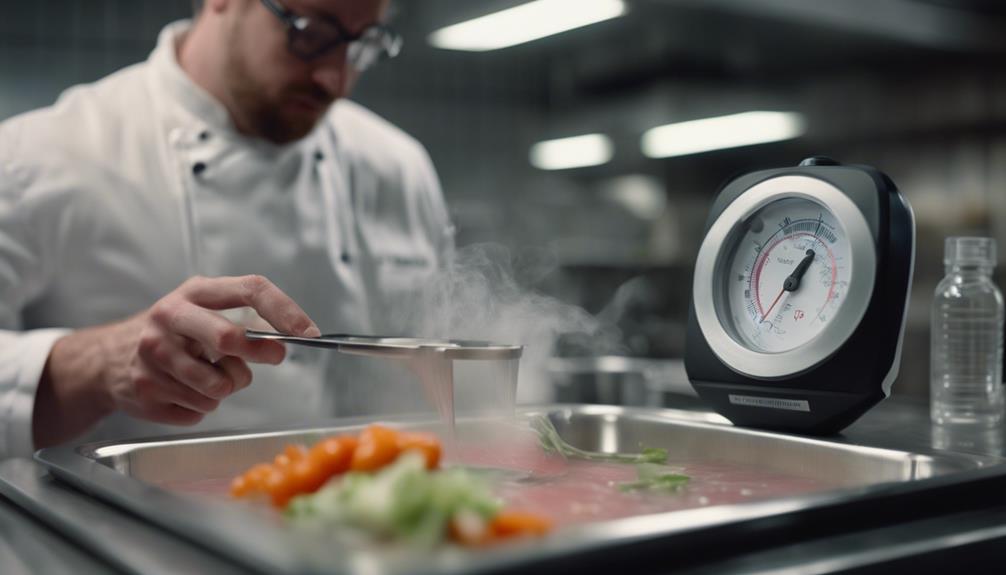
You need to understand the importance of maintaining precise temperature control in sous vide cooking.
Ensuring temperature accuracy is crucial for food safety and preventing the growth of harmful bacteria.
Make sure to calibrate your equipment correctly, monitor temperature fluctuations, and set the desired temperature with precision for safe and delicious results.
Temperature Accuracy Importance
Achieving food safety and desired textures in sous vide cooking heavily relies on maintaining precise temperature control throughout the cooking process. In order to guarantee a safe and delicious culinary experience, it's essential to prioritize temperature accuracy. Here's why:
- Bacteria Elimination: Precise temperature control eradicates harmful bacteria, making your sous vide dishes safe to consume.
- Texture Perfection: Accurate temperature settings minimize the risk of undercooking or overcooking, resulting in perfectly cooked food.
- Flavor Enhancement: Maintaining the correct temperature range is vital for achieving the desired textures and flavors in your sous vide creations.
Equipment Calibration Tips
To guarantee maximum safety and precision in sous vide cooking, you must pay close attention to equipment calibration for maintaining accurate temperature control. Regular calibration of sous vide equipment is essential for ensuring food safety and achieving consistent results. Keeping records of calibration helps track the accuracy of the equipment over time, ensuring reliable performance.
Temperature consistency is key in sous vide to prevent undercooking or overcooking of food, ultimately leading to a safe and delicious culinary experience. Accurate temperature readings also play an important role in pasteurizing food effectively during sous vide cooking.
Monitoring Temperature Fluctuations
How can you guarantee precise temperature control in sous vide cooking to achieve safe and delicious results? Using a high-quality sous vide machine with accurate temperature settings is essential. To maintain ideal control:
- Ensure the water temperature stays within 1°F (0.5°C) of the target temperature.
- Monitor temperature fluctuations closely throughout the entire cooking process.
- Be attentive to any variations in water temperature, as they can impact both the cooking time and safety of your food.
Understanding Pasteurization Times
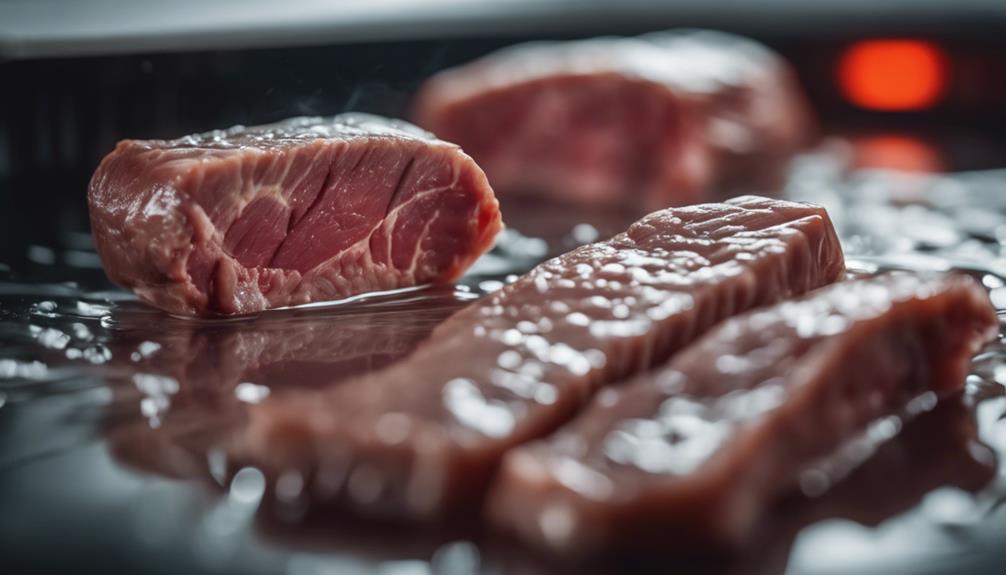
For a thorough grasp of sous vide cooking safety, understanding the precise pasteurization times is vital. Pasteurization, which involves cooking food long enough to eliminate harmful bacteria, is essential when serving vulnerable groups such as pregnant women, the elderly, babies, or individuals with weak immune systems.
In sous vide cooking, pasteurization times are crucial to ensuring the safety of dishes like medium rare steaks, ground beef, lamb, and duck breasts. Did you know that chicken cooked at 140F (60C) and held for 30 minutes is as safe as cooking it at 165F (73.9C) for one second? This method allows for safe consumption without compromising on taste or texture.
Preventing Bacterial Growth Effectively
To effectively prevent bacterial growth in your sous vide cooking, controlling the temperature is essential. By vacuum sealing your ingredients, you can benefit from an oxygen-free environment that inhibits the growth of harmful bacteria.
Make sure you follow recommended guidelines for temperature control and proper sealing techniques to maintain food safety in your sous vide preparations.
Temperature Control Importance
Maintaining precise temperature control above 127F (52.8C) is essential for effectively preventing bacterial growth in sous vide cooking. When you adhere to recommended temperatures, you can control pathogens like Salmonella, E. coli, Listeria, and spore-forming bacteria, ensuring the safety of your meals. Cooking at 130F (54.4C) or higher for extended periods in sous vide inhibits bacterial proliferation, safeguarding vulnerable groups such as pregnant women, the elderly, or those with weak immune systems.
- Precise Control: Keep the sous vide water bath temperature steady above 127F (52.8C).
- Pathogen Elimination: By cooking at 130F (54.4C) or higher, harmful bacteria are effectively eliminated.
- Enhanced Safety: Following pasteurization guidelines guarantees food safety for all, especially vulnerable individuals.
Vacuum Sealing Benefits
When cooking sous vide, make sure that vacuum sealing is used to effectively prevent bacterial growth by creating an anaerobic environment. Vacuum sealing removes oxygen, creating conditions where bacteria struggle to thrive, enhancing the safety of your cooking process.
By eliminating oxygen exposure, harmful bacteria find it difficult to multiply, ensuring your food remains safe for consumption. This anaerobic environment not only inhibits bacterial growth but also helps retain the flavors, nutrients, and moisture in your dishes, resulting in a more delicious culinary experience.
Embracing vacuum sealing as a key safety measure in sous vide cooking guarantees that your food remains both safe to eat and full of delectable flavors.
Rapid Chilling Methods

Rapid chilling methods play an essential role in ensuring the safety and quality of sous vide-cooked food by quickly lowering its temperature to prevent bacterial growth. When it comes to sous vide cooking, implementing proper rapid chilling techniques is essential for maintaining food safety and preventing the growth of harmful pathogens.
To achieve this, consider the following methods:
- Ice Baths: Placing the vacuum-sealed bags containing the cooked food in a bath of ice water helps rapidly cool it down to safe storage temperatures.
- Ice Wands: Another effective way to chill sous vide-cooked food quickly is by using ice wands, which can efficiently lower the temperature and inhibit bacterial growth.
- Immediate Cooling: Ensuring immediate cooling after the sous vide cooking process is crucial as it reduces the risk of spore activation and bacterial contamination, safeguarding the quality of the final dish.
Importance of Time and Temperature
To guarantee the safety and desired doneness of sous vide-cooked food, precise control of time and temperature is essential. When cooking sous vide, maintaining specific temperatures for calculated durations is vital for eliminating harmful pathogens like Salmonella and E. coli. Proper pasteurization at recommended temperatures not only secures food safety but also enhances the flavors in your sous vide dishes.
Understanding the relationship between cooking times and temperatures is key to preventing bacterial growth and creating delicious meals. By following the recommended guidelines for both time and temperature, you can achieve perfectly cooked and safe-to-eat sous vide dishes every time. Remember, precision is your ally in the sous vide cooking process, allowing you to serve up restaurant-quality meals with confidence.
Storage Temperature Recommendations
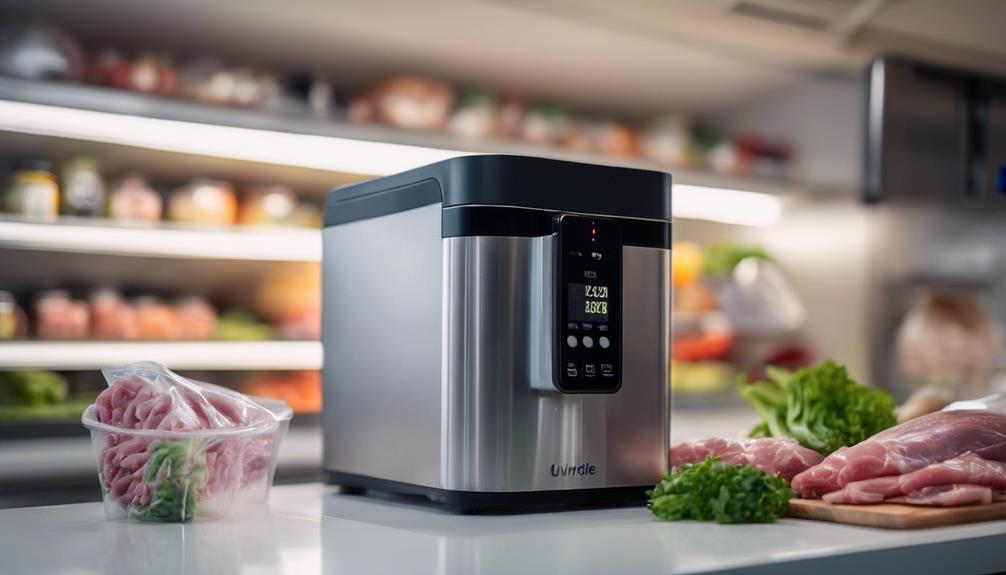
For peak freshness and safety of your sous vide-cooked foods, adhere to specific storage temperature recommendations. When it comes to storing your vacuum-packed foods, maintaining the right temperature is important. Here are some key points to keep in mind:
- Temperature Range: Store vacuum-packed foods between 3°C and 8°C to maintain freshness and safety.
- Duration: Aim to consume your vacuum-sealed foods within 10 days of storage to guarantee top quality.
- Safety Measures: Proper handling and hygiene standards are essential in preventing harmful bacterial growth in vacuum-sealed foods.
Ensuring Flavorful and Safe Results
To ensure flavorful and safe results in sous vide cooking, prioritize maintaining precise temperature control for even cooking while retaining flavor and nutrients through vacuum sealing.
By vacuum sealing your ingredients before cooking, you lock in the natural flavors and essential nutrients, ensuring a delicious outcome. Additionally, using specific time and temperature combinations in sous vide cooking helps reduce harmful bacteria to safe levels, ensuring the safety of your dish.
It's important to be aware of key pathogens such as Salmonella, E. coli, Listeria, and spore-forming bacteria, and employ techniques like pasteurization to control them effectively.
Best Practices for Sous Vide Safety
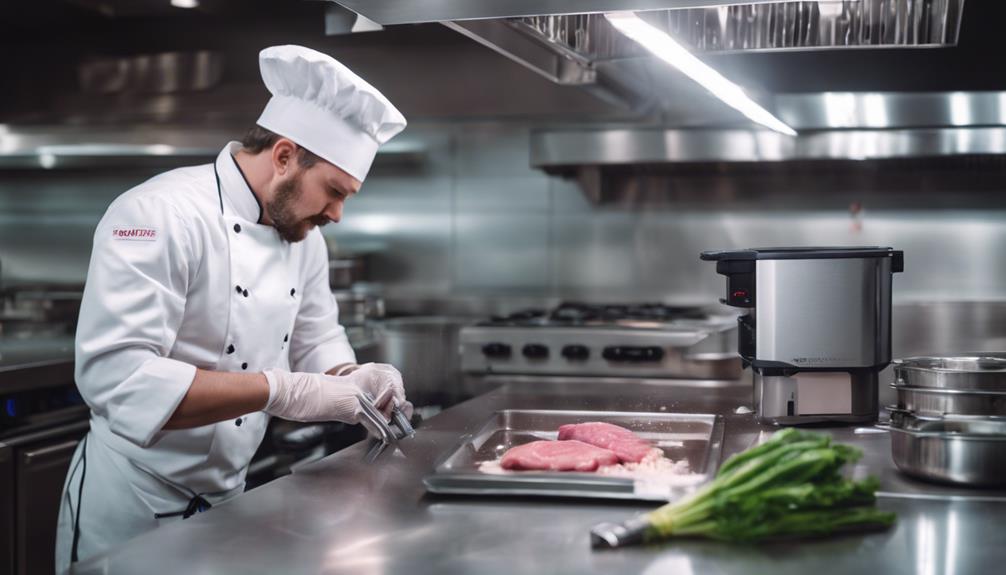
Prioritize safety in sous vide cooking by following best practices to guarantee a delicious and risk-free culinary experience. When it comes to sous vide safety, keep these key points in mind:
- Use food-safe materials: Opt for BPA-free plastic bags when cooking below 127F (52.8C) to ensure safety as recommended by scientists.
- Ensure pasteurization: Pasteurize foods like medium rare steaks, ground beef, lamb, and duck breasts to eliminate harmful bacteria and guarantee food safety.
- Cook poultry correctly: Cook chicken at 140F (60C) and maintain that temperature for 30 minutes to achieve the same level of safety as cooking at 165F (73.9C) for a shorter duration.
Frequently Asked Questions
What Is the Safety of Sous Vide Cooking?
When cooking sous vide, guarantee temperature control for safety. The pasteurization process eliminates harmful bacteria, preserving food quality. Using proper techniques and equipment ensures a delightful and risk-free culinary experience every time you cook sous vide.
What Are the Guidelines for Sous Vide Food Safety?
Maintain precise temperature control to prevent bacterial growth. Vacuum seal food for safe storage. Understand pasteurization levels for cooking times. Your attention to these guidelines guarantees a safe sous vide cooking experience for those you serve.
How Do You Use Sous Vide Safely?
To use sous vide safely, maintain proper handling, precise temperature control, and adhere to recommended cooking times. These steps are crucial for a successful and delicious sous vide cooking experience, giving you safe and flavorful meals.
What Principles Are Applied in Sous Vide Cooking to Make It a Safe Cooking Method?
Maintain precise temperature control, guarantee proper cooking time, and use vacuum sealing to make sous vide a safe cooking method. These principles eliminate harmful bacteria, assuring a delicious and secure culinary experience.
Conclusion
To summarize, adhering to safety guidelines, proper vacuum sealing techniques, precise temperature control measures, understanding pasteurization times, preventing bacterial growth, and storing at recommended temperatures are essential for a safe and delicious sous vide cooking experience.
By implementing these key practices, you can guarantee flavorful results while keeping your food safe from harmful bacteria. Enjoy the convenience and precision of sous vide cooking with peace of mind knowing you're taking the necessary precautions for a successful culinary adventure.
